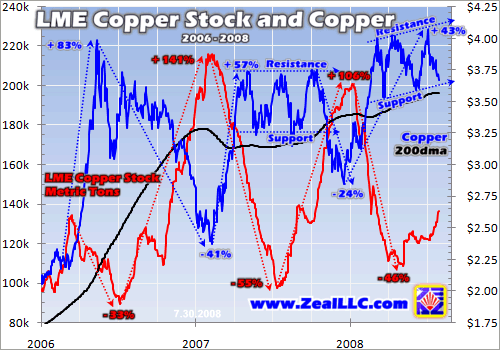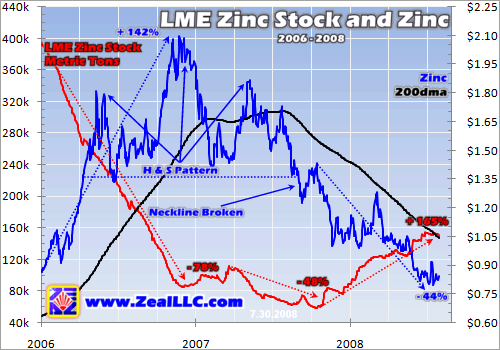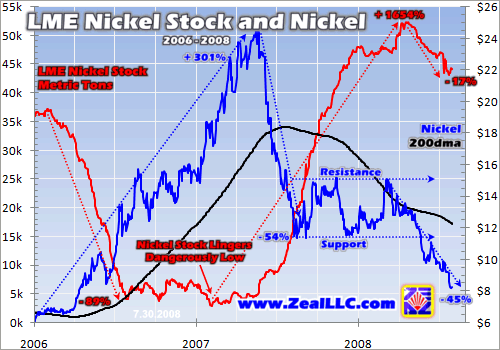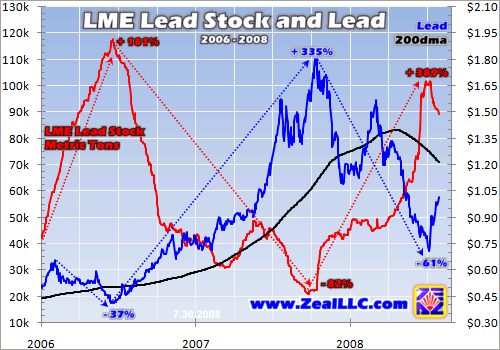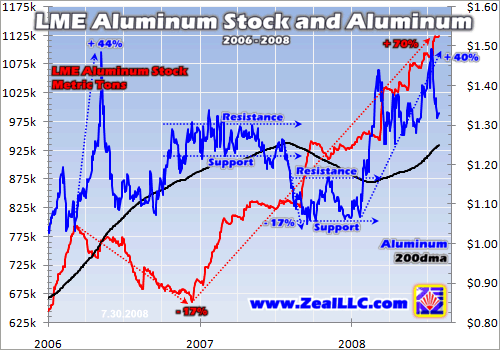|
|
|||||||
|
|
|
|
|
|
|
|
|
|
Base Metals Stockpiles & Prices 4 Scott Wright August 1, 2008 3687 Words
When the base metals bulls began in 2003, few could fathom the wild ride ahead. Fundamentals indeed supported steadily rising prices, but the massive parabolas that unfolded between 2005 and 2007 were amazing to behold. From trough to peak copper, zinc, nickel, lead, and aluminum skyrocketed 475%, 523%, 650%, 829%, and 137% respectively.
This rise of the base metals not only represented yet another powerful breakout within the commodities sector, but a universal acceptance that a global secular commodities bull was upon us. With oil and gold already paving the way, the economic imbalances unfolding in the indispensable metals used in the production of everything structural and mechanical was eye-opening.
Well since the apexes of these wild parabolas, the base metals have seemingly lost their luster. In the process of correcting and consolidating, the excitement has waned and what mainstream coverage they had has fallen by the wayside.
But much to the chagrin of the Johnny-come-lately traders, these corrections were necessary for the greater health of their bulls. Prices simply cannot rise forever. And the base metals were due for imminent corrections, in some cases crashes, to wipe the extreme euphoria.
So while the base metals have fallen off the radars even for many of the commodities faithful, as you will see their bulls are still well intact. And even when the going seems to be rough, it is important to stay on top of these markets and to occasionally take their pulse.
On the supply side of the base metals trade there is a very measurable fundamental that helps us do so. And the data provided by the London Metal Exchange (LME) has been dazzling in gauging the health of the base metals markets.
The LME is the world’s largest non-ferrous (not containing iron) metals exchange and is the most reliable source for daily base metals prices. It also hosts futures and options markets that are second to none. But aside from these central functions, the critical LME function that serves the purpose of this essay is the physical storage of the metals.
The LME stockpiles the base metals to ensure price convergence and the ability to deliver the physical metal if a contract is redeemed. But since hedging and speculating are the most common forms of trading on commodities exchanges with only a small percentage of contracts ever resulting in delivery, the stockpiles offer more utility to those outside of the physical realm.
Since most of the world’s base metals trade takes place directly between producers and consumers, these LME stockpiles are in essence emergency supply. So when there is a global supply and demand imbalance, consumers are able draw upon the inventory that is stored in the hundreds of warehouses strategically located around the world.
LME stockpile levels fluctuate each day as there is constant inflow and outflow of inventory. But when outflow exceeds inflow for an extended period of time it can be inferred that consumers’ needs are not being met via regular supply channels. And inversely if inflow exceeds outflow for an extended period of time, it can be inferred that the suppliers are producing the metals faster than they can be consumed.
Therefore the fluctuations of LME stockpile levels can help paint a good picture of the balance between global supply and demand. And traders watch these fluctuations very carefully as they seem to strongly influence the pricing of the base metals.
Since the LME provides daily data on stockpile levels and prices, we are able to plot it into charts. And this gives us an excellent visual depiction of the relationship between stockpiles and prices. In recent years this relationship has shown us an impressive inverse correlation. And while this correlation hasn’t always been strong or telling, for instance in the bear-market years, lately it has told us a lot.
What gave catalyst to this inverse correlation was sharply-growing base metals demand reducing stockpiles to historically low levels. And at these low levels we’ve been able to use these stockpiles-to-prices correlations to help explain how prices can soar to such lofty levels and also how they are susceptible to the sharp corrections we’ve seen of late.
Diving right in, a lot has happened since the last time I wrote about base metals stockpiles and prices. Late last year we started to see an across-the-board build in LME stockpile levels. And these growing stockpiles were not too kind to base metals prices. This inverse correlation was playing out perfectly. And like I suspected prices were in the midst of sharp corrections.
While long-term fundamentals remained relatively strong for the base metals, the tactical LME stockpiles fundamentals were screaming for corrections. When stockpiles were low, massive speculative risk premiums were attached to prices. So when stockpiles started to rise, prices were quick to shed these premiums.
Copper is the stalwart of the base metals group. And even though aluminum swings around more capital, copper captures the most attention from the financial markets. In fact, during its massive parabolic rise in 2006 CNBC gave copper a headline quote that continually flashed alongside gold and silver.
And copper best illustrates this stockpiles-to-price inverse correlation. Interestingly as recent as 2002, LME copper stockpiles were at 1m metric tons. But when growing demand from the world’s developing nations bled dry the normal supply channels, the warehoused stockpiles were the next logical place to go to satiate the growing hunger for copper.
From 2002 to 2005 outflows from LME warehouses greatly exceed inflows, and copper stockpiles plummeted. LME copper stockpiles fell by over 90% before they finally bottomed in 2005. And this fundamental strain on the global copper trade was more than enough to warrant a skyrocketing copper price.
With copper stockpiles at the low levels we’ve seen in the last several years, the stockpile-to-consumption ratio is now measured in days, not weeks as it was before this bull began. So with global copper consumption at about 50k metric tons each day, copper stockpiles fluctuating between about 100k to 200k metric tons reflects a really tight supply.
With only two to four days worth of LME copper stockpiles on hand at any given time, a risk premium has been placed on copper’s price that has shot it to all-time highs. And in its current range we can see that there is a level of comfort that speculators will accept on a daily basis.
This level of comfort moves copper’s price inversely to the daily movement of LME stockpile levels. When stockpiles grow, the price retreats. And when they fall, speculators bid up copper’s price for the added risk of such dangerously-low stockpile levels.
On a side note, according to the International Copper Study Group (ICSG), LME stockpiles account for about 75% of the above-ground measurable supply when the stockpiles of the other major metal exchanges (SHFE and COMEX) are factored in. This explains the major influence LME stockpile levels have on global base metals prices.
Back to the task at hand you can definitely see this inverse relationship in the big swings. And we can quantify this mathematically as well. For example, from when copper broke to the downside of the mid-2007 sideways trend channel to today there is an inverse correlation of -0.933 with an r-square of 87%. This means 87% of the daily behavior of copper from early November 2007 to current could be explained by the inverse movement of its daily LME stockpile levels. This is a very tight inverse correlation.
Currently LME copper stockpiles are on the low side of their three-year range which has supported an impressive 2008 upleg. Copper has gained 43% since its December 2007 low and is currently in an upward-sloping trend channel that just recently saw it achieve another all-time high.
Looking forward one thing is certain for copper, it will remain volatile. According to the ICSG the world’s supply of copper from refined production has fallen short of meeting demand in the first half of 2008. And this would explain the recent low stockpile levels.
But the ICSG also forecasts a supply surplus in the second half of 2008 and all of 2009. While this surplus is expected to be modest, if true this would likely grow stockpile levels and subsequently lower prices. But since forecasts are just professional guesses, and any number of environmental and economic factors can affect global copper supply, we’ll have to wait and see how the stockpiles play out.
Now looking at these next three charts you can see why base metals have lost popularity. And zinc has simply been crushed! In fact considering the price action of zinc in the last couple years, you’d think this metal was going to zero! Since its apex in early December 2006, zinc has methodically shed over 60%.
Similar to the other base metals, zinc experienced a series of parabolic ascents from the second half of 2005 through the end of 2006. And the catalyst to this meteoric rise was plummeting LME stockpiles. From levels in excess of 700k metric tons prior to 2005, stockpiles fell by nearly 90% before they finally started to bottom toward the end of 2006.
As LME stockpiles began to stabilize, zinc entered into what turned out to be a glaringly obvious head-and-shoulders pattern. Unfortunately head-and-shoulders patterns are usually bearish and lead to trend reversals. And this is what happened with zinc. The neckline broke and zinc continued to fall off the right shoulder.
But what happened off this right shoulder was counter to the usual stockpiles-to-price inverse relationship. As the LME stockpiles continued to fall, so did the price of zinc. These alarming new mid-2007 lows occurred in the 60k metric-ton range which was the equivalent of just over two days worth of global zinc consumption. This should have terrified the zinc markets!
In retrospect the lack of fear at these stockpile levels was due to the anticipation of increased supply coming online in the subsequent years. And this broader market reality was the reason for the technical anomaly seen in this chart. In Q4 2007 LME zinc stockpiles indeed began to rise. And of course the price of zinc took no respite, adhering to the stockpiles-to-price inverse correlation and continuing to fall.
But lest you think zinc’s bull is over, think again. If you look at a zinc chart that goes back to when its bull began in 2003, an upward-sloping long-term support line can be drawn in that would still be well under today’s seemingly low prices. In fact, even at today’s prices zinc is still around 150% above its 2003 low of $0.34.
Interestingly with rising operating and refining costs, many of the primary zinc producers will not be able to operate profitably if prices go much lower. While zinc supply is expected to rise, which will put further downside pressure on its price, I suspect we are getting to an oversold level that could threaten future supplies if overdone.
Looking at a nickel chart we have a similar story to zinc. From its early 2006 levels LME nickel stockpiles plunged 89% in short order as consumers filched the warehouses. Sub-5k-metric-ton stockpiles are the equivalent of about one day worth of global consumption. And because of this the speculators placed a huge risk premium on nickel’s price.
As nickel stockpiles lingered at these dangerously-low levels, nickel’s price continued to skyrocket through Q2 2007. But as the market found its balance and inflows from increased production raised the warehouse levels, the speculative risk premium was quick to dissipate.
In a matter of months nickel lost over half its value before it settled into a sideways trend channel. From the initial bottom of this sharp crash nickel appeared to have found a base as it meandered in the $12 to $15 range for about nine or so months. But in May nickel decisively broke through support and continued to slide even though the stockpile build leveled off and started a slide of its own.
Even from its 2008 high, nickel has shed another 45% while dropping under $10 for the first time in over two years. But although it appears as though nickel is in the pits, it is still 150% higher than its 2003 low. Nickel’s bull market is still intact, but this extreme volatility demonstrates what can happen during a major supply/demand imbalance, no matter how temporary it is.
Nickel effectively underwent an auction-type bidding war led by the speculators. With a glut of bidders and limited supply, quite a lofty premium was placed on this highly-sought-after metal. Ultimately since it rounded the corner from its all-time high of $24.54, LME stockpiles have mounted a massive +1500% build.
So now with over 12 days of equivalent daily consumption available in the LME stockpiles, the inverse correlation has seemingly lost its effectiveness for the time being. Going forward nickel will be challenged with mined supply on the rise and demand growth easing a bit. But I really don’t see its price falling too much lower from here.
Moving on to lead we see activity similar to that of zinc and nickel, but slightly delayed. Lead’s bull left the gates a little later than the rest of the base metals as dictated by its stockpile levels. It wasn’t until mid-2006 that LME lead stockpiles began their swift descent. And as you can see prices reacted as one would expect.
When LME lead stockpiles shed over 80% in just over a year, resulting in equivalent daily consumption of only about one day, lead experienced a powerful upleg that saw its price gain over 300%. This parabolic rise reached its apex at $1.80, which is simply unheard of. At the time lead was worth more than aluminum and zinc!
But as soon as the LME stockpiles started to climb in Q4 2007, lead’s risk premium was quick to dissolve. Over the course of about nine months stockpiles quintupled and lead’s price took a dive, losing over 60%. And the stockpiles-to-price inverse correlation continues to work quite well for lead.
Not only is this inverse correlation visually striking, but so far in 2008 it measures at -0.860 with an r-square of 74%. This is not as tightly correlated as say copper and its stockpile levels, but highly correlated nonetheless.
In this chart it may look high, but 100k metric tons is only about five days worth of inventory. And it is likely that as long as LME lead stockpiles oscillate around the 100k-metric-ton level, its inverse correlation to price should continue to be telling.
Overall lead’s bull market remains in fine shape even with the sizeable speculative excess being shaved. In fact its current price is still over 400% higher than its 2003 low. And according to the International Lead and Zinc Study Group a running five-year supply deficit might well turn into a six-year deficit if 2008 lead production has a weak second half.
Last and certainly not least is aluminum, and its chart is very similar to that of copper’s. Perhaps it is the sheer size of the aluminum market, but as you can see its volatility has nowhere near the extremes as the other base metals. Interestingly, measured by volume more aluminum is mined and consumed each year than all the other base metals combined.
Like the other base metals, LME aluminum stockpiles underwent a huge draw that led to an early 2006 spike to all-time highs. With stockpiles more than halving from late 2003 to the late 2005 lows near 500k metric tons, the price of aluminum more than doubled. But provocatively aluminum’s post-spike price action is counter to the usual stockpiles-to-price inverse correlation.
For about a year aluminum had a nice high consolidation after its early 2006 spike. And as would be expected, in the middle of 2007 aluminum broke to the downside as LME stockpiles continued to rise. After shedding 17% aluminum then settled into another sideways trend as stockpile levels lingered.
But as LME stockpile levels continued their rise in early 2008, the price of aluminum also began to rise. Oddly enough even though stockpiles grew by 70% since their late 2006 lows, aluminum’s price has risen on balance over this same period of time and recently achieved another all-time high. So it is apparent that some other external factor is driving aluminum’s price higher. And this factor resides at the smelter level.
Smelting in general is the process of chemical reduction in which metal is produced from ore. And while all smelting is very energy-intensive, aluminum smelting takes the crown. Aluminum smelting is an electrolytic process and requires massive amounts of electricity.
Not only has this energy-intensive process been catalyst to skyrocketing operating costs, but there have been substantial power-related production losses at some of the world’s largest aluminum smelters. This has yet to noticeably affect the LME stockpile levels, but these are issues that are currently adding a risk premium to the price of aluminum.
Circling in, we can see that the relationships between LME base metals stockpiles and their respective metal’s prices are mixed at this point in time. While they have all been slave to the stockpiles-to-price inverse correlation in recent years, a variety of environmental factors has allowed some of the metals to occasionally deviate from this relationship.
Copper, zinc, and lead are currently adhering to this inverse correlation based on their historically low LME stockpile levels. Flows and ebbs in these low stockpile ranges allow lofty risk premiums to come and go. But nickel and aluminum are currently going against trend. Nickel because of its high stockpile-to-consumption ratio and aluminum thanks to environmental factors closely tied to the soaring price of energy.
I also suspect that the current global economic slowdown is having a material impact on base metals, thus contributing to rising stockpile levels. While demand for base metals is continuing to rise, the growth rate is not as sharp as in previous years. And this has allowed supply to temporarily catch up with demand. But economic cycles are nothing new to the commodities markets.
Even if the emerging economies responsible for much of the growth take a breather with the rest of the world, their development is not going to grind to a halt. In fact many experts believe that these economic woes mixed with higher base metals prices have prompted governments and consumers to destock their own inventories.
While destocking reduces capital expenditures in the interim, it also drops stockpiles to very low levels. So when the economy does turn around or when ‘local’ stockpiles get too low, consumers will need to restock which will place a huge strain on supplies.
Ultimately the main reason I analyze the base metals is to better understand their bulls and to apply this knowledge to trading. And as stock traders our options for trading the base metals bulls now extend beyond the mining stocks. Whereas futures traders ruled the roost before, the advent of ETFs and ETNs now allows stock traders to gain direct exposure to base metals prices.
First to the scene was the venerable DBB ETF that invests its assets in futures contracts weighted one-third each in aluminum, copper, and zinc. And now there are 10 base metals ETNs that also provide direct futures exposure. These ETNs range from diversified group notes, to individual base metals notes, and even leveraged (2x) long or short notes.
And while ETFs/ETNs provide exciting new exposure to base metals prices, we still can’t forget about the mining stocks. Over the years these stocks have won fortunes for investors and speculators with the excellent positive leverage they provide relative to the performance of their underlying metals.
But caveat emptor on these mining stocks in a bear-market downleg. Unfortunately many base metals mining stocks are correlated with the general markets. Because of their large size many of these stocks are constituents of major indexes. And this makes them susceptible to institutional selling. Many of these stocks simply don’t have the fundamentals to defy general market tendencies like gold and silver.
This is why during stock bears it is wise to shy away from the larger base metals stocks. In recent newsletters and essays we’ve explained in depth how this current bear downleg can adversely affect larger commodities stocks. Not only base metals but energy stocks have been decimated alongside the markets in the last couple months. This is another reason why ETFs/ETNs have become such valuable trading vehicles.
At Zeal we’ve profitably traded base metals mining stocks for many years. And we look forward to going long these stocks once again. For now we’ll consider futures via ETFs/ETNs while the general-stock bear downleg runs its course. But when base metals fundamentals line up and we aren’t fighting stock-market headwinds, it will be time to back up the truck!
In our monthly and weekly newsletters we’ve been preparing our subscribers for this general-stock bear. And there are a myriad of opportunities, both long and short, to successfully trade it. If you join Zeal you’ll gain access to cutting-edge market analysis and real-world trade recommendations. Please subscribe today!
And as a newsletter subscriber you also gain access to the exclusive subscriber charts section on our website. We update an assortment of unique short-term and long-term base metals charts. And our subscribers have been able to watch the stockpiles-to-prices correlations unfold right before their eyes via weekly updates of the charts you see above.
The bottom line is as long as LME stockpile levels remain historically low, there should continue to be strong inverse correlations to prices. And with the corrections and consolidations we’ve seen in the last year or so, it is apparent that the base metals are trying to find a balance in this challenging economy.
Overall the base metals bull markets are still intact. Take away the parabolas and their respective corrections and each of the metals is trending upwards as growing global base metals demand continues to challenge supply. And while we are not at a major inflection point for trading the base metals yet, it is of utmost prudence to keep an eye on their activities via the LME data.
Scott Wright August 1, 2008 Subscribe |
|||||||
|
|
|
|
|
|
|
|
|
|
|
|
|
|
|
|||

